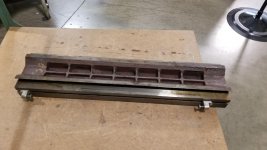samuel.stroth
Plastic
- Joined
- May 24, 2019
Hello everyone,
I have basically no experience or knowledge on milling machines or machining in general so excuse me if this is an obvious question. But I am a mechanical engineering student and I have a co-op job that has a mill that needs to be brought up and running. It's an old Enco 100-1525 mill from the mid 90s and literally nobody makes parts for them anymore. I've managed to get it pretty much up and running except the bench is very stiff to move side to side. I had the machinist that works with our company from time to time machine me a bearing retainer and he also gave me an old dial holder from a pile of miscellaneous parts he's had laying around for like 20 years that just happened to fit. I put these on and I go to turn the handle to move the bench to the right, finally having gotten the parts together and getting it in working order (or so I thought), just for it to be incredibly difficult to turn. I thought it was just that the lead screw needed greased up or something so I went to take the whole lead screw assembly apart for the x axis, and it moved fine after I took the right side assembly off of the lead screw. I then put it back together piece by piece so that I could figure out where the stiffness was coming from and it seemed to be when I put the end cap with the bearing in it that it got stiff and hard to turn. I checked the bearing and it rotates just fine by itself so I'm not sure why it gets hard to move the whole assembly when I put the bearing on, even without the bearing retainer. Does anyone have any ideas as to why it's hard to turn when I put that part on, and maybe have some advice on how to fix this? Anything would be appreciated, even just some resources on where I can learn more about this stuff (specifically this particular enco machine).
Also if anyone knows where to find parts for old Chinese milling machines like this one, that would be spectacular. The only thing I have left that I really need to find is the end cap nut on the left side of the x axis lead screw. I can't even tell what size it is because it's so weird. I thought it was a 9/16 inch nut but that was just barely too small. My next guess is a 14.5mm nut but I don't even know where to find something like that.
I have basically no experience or knowledge on milling machines or machining in general so excuse me if this is an obvious question. But I am a mechanical engineering student and I have a co-op job that has a mill that needs to be brought up and running. It's an old Enco 100-1525 mill from the mid 90s and literally nobody makes parts for them anymore. I've managed to get it pretty much up and running except the bench is very stiff to move side to side. I had the machinist that works with our company from time to time machine me a bearing retainer and he also gave me an old dial holder from a pile of miscellaneous parts he's had laying around for like 20 years that just happened to fit. I put these on and I go to turn the handle to move the bench to the right, finally having gotten the parts together and getting it in working order (or so I thought), just for it to be incredibly difficult to turn. I thought it was just that the lead screw needed greased up or something so I went to take the whole lead screw assembly apart for the x axis, and it moved fine after I took the right side assembly off of the lead screw. I then put it back together piece by piece so that I could figure out where the stiffness was coming from and it seemed to be when I put the end cap with the bearing in it that it got stiff and hard to turn. I checked the bearing and it rotates just fine by itself so I'm not sure why it gets hard to move the whole assembly when I put the bearing on, even without the bearing retainer. Does anyone have any ideas as to why it's hard to turn when I put that part on, and maybe have some advice on how to fix this? Anything would be appreciated, even just some resources on where I can learn more about this stuff (specifically this particular enco machine).
Also if anyone knows where to find parts for old Chinese milling machines like this one, that would be spectacular. The only thing I have left that I really need to find is the end cap nut on the left side of the x axis lead screw. I can't even tell what size it is because it's so weird. I thought it was a 9/16 inch nut but that was just barely too small. My next guess is a 14.5mm nut but I don't even know where to find something like that.






